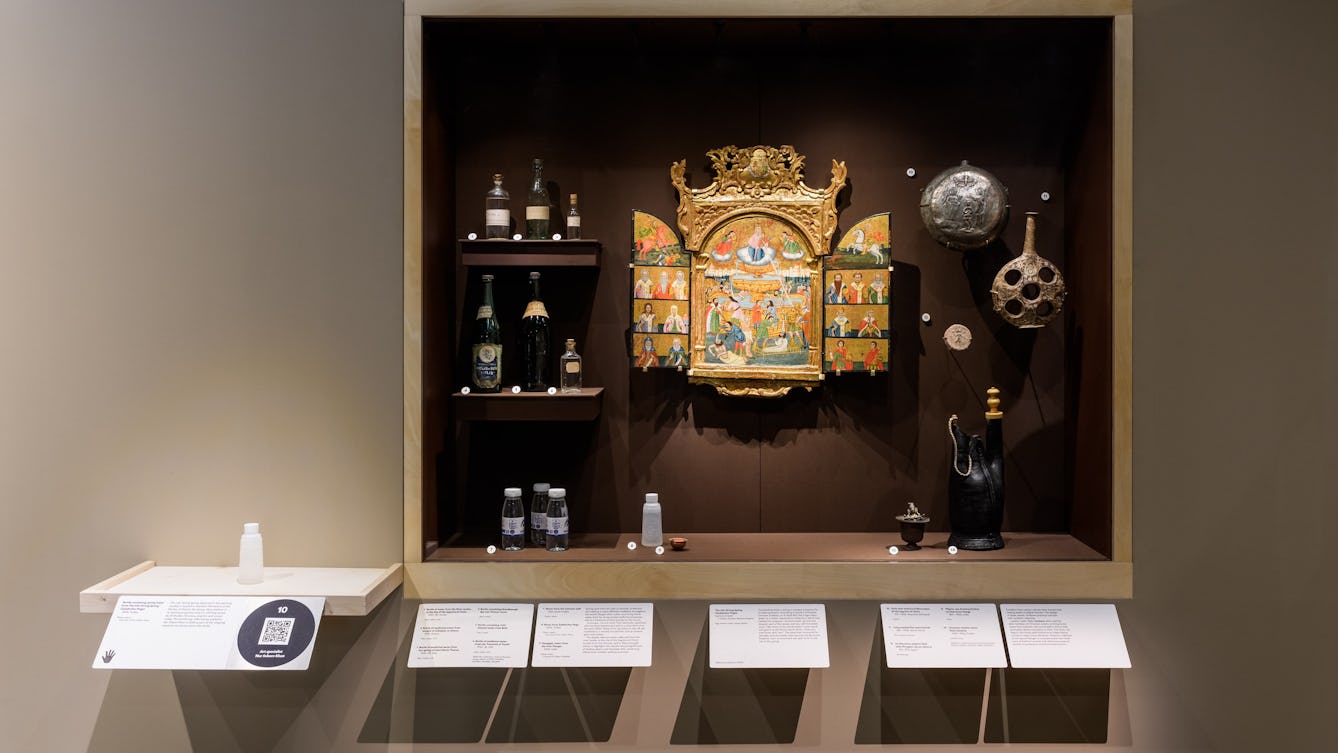Hi. My name is Nur Sobers-Khan; I am a specialist in Middle Eastern and South Asian art. Over the last year I’ve been researching and visiting sacred springs throughout the Islamic world, looking to better understand historical and contemporary practices around water and pilgrimage.
On the shelf, just above the QR code for this stop, is small plastic bottle filled with holy water that I collected from one such site, the Monastery of the Life-giving Spring in Istanbul, Turkey, known as Zoödochos Pege in Greek, or Balıklı Meryem Ana Kalisisi in Turkish. The front of it has an imprint of the Virgin Mary, surrounded by Greek text. Feel free to gently touch this object.
I remember visiting this shrine, how interesting it was to see both Muslim and Christian people taking in the waters, and just how very seriously they took this ritual. I was there as a scholar and casual anthropologist. I hold some of these beliefs myself or I find them touching and meaningful on a human level. But hearing the visitors explain how they understand what is happening in the shrine, the imbuing of the water with sacred or magical properties, added a new dimension to my understanding.
This water from the underground spring at this monastery has been believed to have healing powers since at least the fifth century, and is associated with miracles of the Virgin Mary. One such miracle is depicted in a painting in the wall-recessed case, to the right of the shelf.
In the centre of the case is an ornate triptych made out of gilded wood and delicately painted in bright reds, blues, greens and gold. The triptych is arranged in three panels. The door panels on either side each take the shape of half an arch. The inside of each door is divided into four postcard-sized panels, each painted with the images of saints set against a gilded background.
The central panel is arch-shaped, recessed within a carved and gilded rectangular frame. Here, a miraculous scene appears before us. It shows the walls of the ancient city of Constantinople (now Istanbul) on the horizon – lapped by the waters of the Bosphorus, punctuated by the tops of cypress trees.
The centre of the image is occupied by a three-tiered stone fountain – the Life-giving Spring. Water flows into its curvy-edged basins – like a series of wine glasses set one on top of the other. Above the sacred spring, the Virgin Mary sits on a cloud, swathed in a blue robe and pink shawl, her head topped with a crown. Angels attend to either side of her and the Christ Child is perched on her knee.
A line of light and holy words travel from Mary’s mouth to a man dressed in golden Roman military armour and a green tunic. In the legend this soldier stumbles across the shrine and uses its sacred waters to cure a blind man at the behest of the Virgin.
The blind man recovers his eyesight, and the soldier later becomes both a saint and the Byzantine Emperor, Leo I. The waters are also curing two other figures, a paralysed man who has been carried in on a litter, and what would have historically been described as a ‘madman’, wrapped in bandages.
Istanbul is an ancient city. Before it was the Ottoman capital, it was the Byzantine capital, Constantinople. And before Byzantium became Christian, it was a centre of Greek and Roman pagan worship as well. Each water-pilgrimage site will have layers of historical and cultural accretions and meaning. They often have a subterranean, almost underworld, element to them, an association with life and rebirth. The Life-giving Spring is underground, and situated in the middle of a vast cemetery, with many different Christian and Muslim communities represented. In the surrounding neighbourhoods, you have a number of Muslim shrines as well that are also associated with life, healing and water.
The site of this holy spring is still very much in use today. For the large numbers of Christians, as well as Muslims, who continue to visit the monastery, there is a very genuine belief in the power of the water to cure illness.
Many other shrines in Istanbul are also still active, and very much woven into the mythology of the city. Nowadays they are not just associated with healing the sick and curative powers, but also with wishes for love, marriage and children.
These kinds of water shrines and their practices reflect, and are very adaptable to, human wishes and needs. This is perhaps unsurprising. Water is something so basic and essential to human life that it really transcends any kind of religious boundaries.
This is the end of Stop 10.
